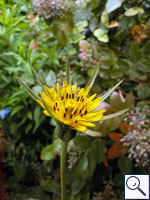|
||||||
|
TRAGOPOGON. Goat's-beard and Salsifies. [Asteraceae] |
|
|
Four species of Tragopogon are recorded in Britain. These include the native Goat's-beard (T. pratensis) and the introduced Slender Salsify (T. hybridus) and Salsify (T. porrifolius). The BSBI provide a downloadable plant crib for subspecies of Tragopogon pratensis. Five british miners are recorded on Tragopogon. The polyphagous agromyzid Liriomyza trifolii has been recorded in quarantine in Britain (Pitkin & Plant in British leafminers). See also Liriomyza species in Glasshouses and/or Quarantine Interceptions. A key to the European miners recorded on Tragopogon is provided in Bladmineerders van Europa. |
|
Key for the identification of the known mines of British |
1a > Stem miner: An external stem mine with frass in two rows of disconnected strips. Pupation in stem at end of mine (Spencer, 1972b: 25; Spencer, 1976: 61 (fig. 63B), 65-6). |
|
Ophiomyia heringi Stary, 1930 [Diptera: Agromyzidae]. |
| 1b > Leaf-miner |
2a> Leaf-miner: Green, later brownish corridor or more often an elongated whitish linear blotch overlying the midrib. The mine has short, irregular side branches. Frass in irrgular, dispsersed grains. Pupation outside the mine. |
|
Liriomyza tragopogonis (Meijere, 1928) [Diptera: Agromyzidae]. |
2b > Leaf-miner: Upper-surface, unusually short corridor (ca. 4 cm). Sometimes several mines in a leaf. Pupation outside the mine. |
|
Liriomyza pusio (Meigen, 1830) [Diptera: Agromyzidae]. |
2c > Leaf-miner: A distinctive mine primarily above mid-rib, with irregular short lateral offshoots into leaf blade. Pupation external (Spencer, 1972: 51 (fig. 172), 55; Spencer, 1976: 270, 271 (fig. 486)). Branched, whitish, upper-surface corridor; main axis overlying the midrib; side branches overlying the main lateral veins. (In Campanula and Phyteuma the mine is much less branched, sometimes nothing more than a corridor on top of the midrib). Frass in rather long strings. Usually the mines begins as a long and narrow, shallow, tortuous lower-surface corridor that ends upon the midrib but otherwise is not associated with the leaf venation. Often this initial corridor is filled with callus, and then even less conspicuous. Pupation outside the mine. A linear mine on the upper surface, usually following the midrib and showing side branches along the veins. The frass is in strings. |
|
Liriomyza strigata (Meigen, 1830) [Diptera: Agromyzidae]. |
2d > Leaf-miner: Mine linear, whitish, both upper and lower surface. Pupation internal, at the end of the mine with the anterior spiracles projecting through the epidermis (Spencer, 1976: 433). Upper-surface, less often lower-surface corridor. Frass in isolated grains. Pupation within the mine, usually in a lower-surface puparial chamber. A long whitish upper surface corridor, which eventually goes lower surface. |
|
Chromatomyia
horticola (Goureau, 1851) [Diptera: Agromyzidae] |
| Last updated 07-Jul-2019 Brian Pitkin | ||

